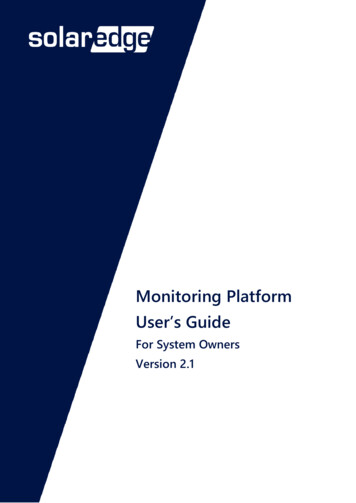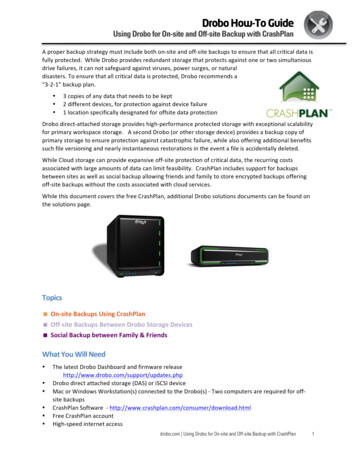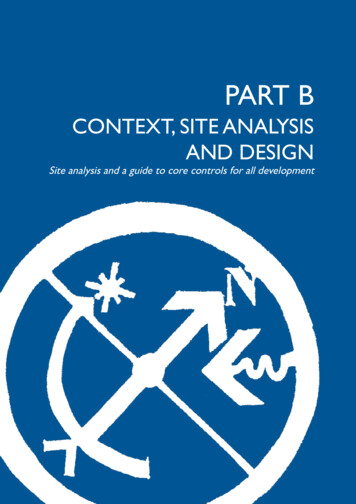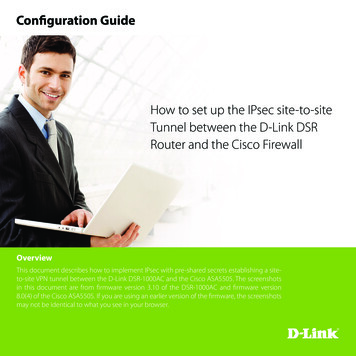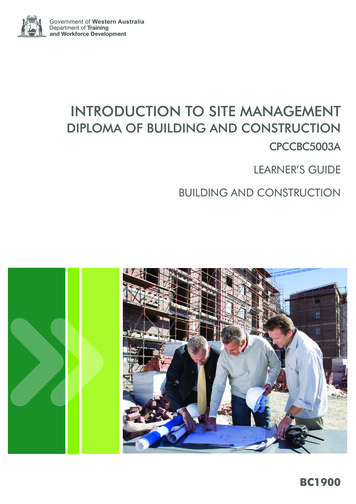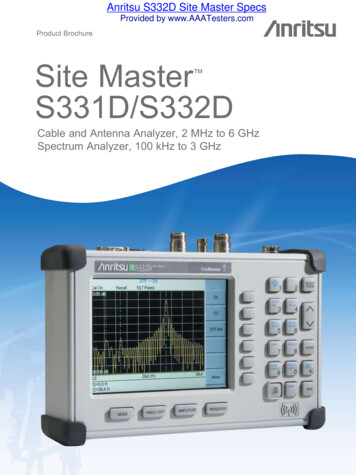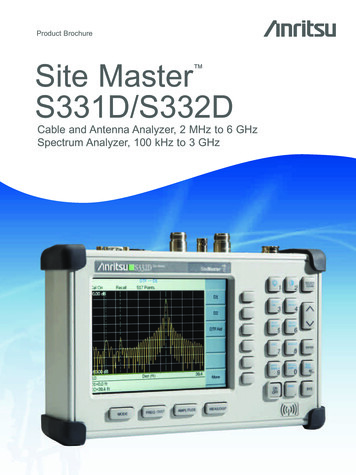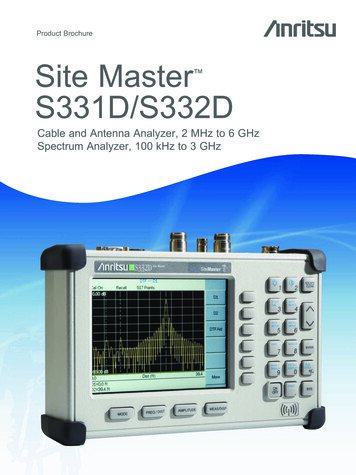
Transcription
December 2015GOOD SITEPRACTICE ANDWORKMANSHIPBrick Development Associationwww.brick.org.uk
2GOOD SITE PRACTICE AND WORKMANSHIPContentsPageINTRODUCTION3ORDERING BRICKS3SITE REFERENCE PANEL4DELIVERY AND STORAGE5HANDLING AND BLENDING6SETTING OUT AND SIZE TOLERANCES7MORTAR JOINTS8NOTES ON BRICKLAYINGPROTECTION OF BRICKWORKCHECK LIST9-1112-1314
3GOOD SITE PRACTICE AND WORKMANSHIPINTRODUCTIONThe standard of site practice and workmanship in the course of construction will have the greatestinfluence upon the quality of the finished brickwork. Bricks, mortar and other ancillary components suchas lintels, ties and cavity trays must be designed and specified in accordance with all relevant codesand best practice.High levels of workmanship and site practice should result in durable brickwork of a natural andconsistent appearance requiring little or no maintenance within its design life.This document sets out to assist all members of the building team including, site supervisors andbricklayers by providing guidance on good site practice and workmanship relating to brickworkoperations.Brick manufacturers have a vested interest in the achievement of successful brickwork and are able tohelp and offer advice on all aspects of workmanship and site practice.ReferencesBS EN 771-1: Specification for masonry unitsPAS 70 Guide to appearance and site measured dimensions and toleranceBS 8000-3 Workmanship on building sitesPD 6697 Recommendations for the design of masonry structures.NHBC StandardsORDERING BRICKSl Consult with the brick manufacturer at the earliest convenience and preferably involve themin appropriate pre-contract meetings and discussions.l Fluctuations in market demand can affect the availability of certain brick types.l An accurate delivery schedule with the bulk order is necessary in helping the brick supplierplan availability and delivery.l Special shape bricks are commonly made as bespoke items and often subject to lead times.Early consultation with the brick manufacturer is imperative to avoid any inconvenient impacton the contract programme.Brick Development Associationwww.brick.org.uk
4GOOD SITE PRACTICE AND WORKMANSHIPSITE REFERENCE PANELSBrickwork reference panels are important and necessary. They provide the opportunity to identify andappreciate the inherent characteristics of the brick type specified such as colour, shape, size andtexture. They will demonstrate and set the general standard of workmanship and appearance that canbe reasonably achieved by the bricklayer from the materials specified. Site reference panels provide anessential benchmark should any issues arise during the brickwork programme.l Site reference panels should always be constructedwith the involvement of the brick manufacturer.1l Construct on a solid level base, where the panel can beviewed from a distance of 3 metres in natural daylightand in a location where it will remain undamaged andprotected during the duration of the contract.l Construct the panel so that not less than 1m2 of brickfaces are exposed.l The bricks must be supplied by the manufacturer as arepresentative sample and not be subject to any furtherselection on site.l The panel should be constructed to a standard that canbe maintained by the bricklayers for the duration of thecontract.l Construct to the chosen brick bond and incorporate thespecified mortar, joint profile and colour. Special shapesand other relevant features may also be incorporated.32l Judgement and acceptance of the panel should takeplace from a distance of 3m when the mortar has driedand in the presence of all appropriate parties whichmust include the brick manufacturer.Note: The above guidance reflects Publicly Available Specification PAS 70and brickwork supervisors should make reference to this document.3Brick Development Associationwww.brick.org.uk
5GOOD SITE PRACTICE AND WORKMANSHIPDELIVERY AND STORAGEl Consider the access arrangements and ensure that the delivery vehicle can be safelymanoeuvred to the desired point of delivery.l Provide a firm, level, clean and well drained base to allow safe delivery and storage.This area should not be at risk of soiling from passing vehicles or other adjacent site operations.l Check that the consignment is the correct type and quantity. A number of bricks should be randomlyselected from the delivery to ensure that their appearance is reasonably consistent with the sitereference panel.l Fired clay is hard and durable but can be susceptible to chipping so care should alwaysbe taken to place the packs carefully with the forklift and avoid allowing any distortion of the packshape to occur. Some products are not suitable for lifting by a grab, consult the manufacturer.l Bricks must be kept covered in storage and protected from inclement weather. Excessivelywet or saturated bricks are difficult to lay and can give rise to the risk of efflorescence, lime leachingand mortar staining.347Brick Development Association3www.brick.org.uk
6GOOD SITE PRACTICE AND WORKMANSHIPHANDLING AND BLENDINGl Care should be taken during handling to avoid chipping and damage. Once the bricks are stackedat the point of use they should be protected from the elements whilst bricklaying is not in progress.l Packs should only be opened with sharp band cutting tools. Use of a lump hammer and bolster tobreak the bands should be avoided as this gives rise to chipping, breakages and potential collapseof the pack.l To avoid colour banding or patches within the finished brickwork it is important to ensure that bricksare well blended. Bricks should be blended from a minimum of 3 packs concurrently with someoverlap between the deliveries where possible.l Each manufacturer will have factory specific opening instructions for optimum blending – refer tomanufacturer’s recommendations.l Where circumstances allow it will be beneficial to take receipt of as many bricks as possible at anearly stage to maximise colour consistency throughout the project.BELOW: Poor blending of brickscan result in unsightly banding ordemarcation lines.BELOW: Correct blending from 3packs or more concurrently as thework proceeds.563737Due to the nature of fired clay one of the characteristics that can be inherent is variation in colourshade. To avoid colour banding or patches within the finished brickwork it is important to ensure thatbricks are well blended. Although as much practical blending as possible will be employed at the brickfactory, there is no substitute for blending on site. Bricks should be blended from a minimum of 3 packsconcurrently with some overlap between the deliveries where possible. Refer to the manufacturer forany individual product enquiry. Where circumstances allow it will be beneficial to take receipt of asmany bricks as possible at an early stage to maximise colour consistency throughout the project.Care should be taken during handling to avoid chipping and damage. Once the bricks are stacked at thepoint of use they should be protected from the elements whilst bricklaying is not in progress.Brick Development Associationwww.brick.org.uk
7GOOD SITE PRACTICE AND WORKMANSHIPSETTING OUT / SIZE TOLERANCEl Bricks are manufactured to declared dimensional tolerances which acknowledge and take intoaccount the characteristics of both the raw material and the manufacturing process.Table 1 below sets out these declared dimensional tolerances.Table 1DIMENSIONAL TOLERANCE T1LENGTHWIDTHHEIGHT209mm to 221mm98mm to 107mm62mm to 68mmDIMENSIONAL TOLERANCE T2LENGTHWIDTHHEIGHT211mm to 219mm100mm to 105mm63mm to 67mmNote: for 215 x 102 x 65mm only.l Before bricklaying commences it is advisable to set out a course of bricks dry in the requiredbond pattern. This dry course should be laid out to brickwork co-ordinating size and takeconsideration of openings.l Time taken to set out the brickwork appropriately at this stage will help to avoid setting out errors aswork proceeds.l The setting out of general brickwork should normally be to the co-ordinating sizes of 225mm forlength and 75mm for height with any tolerance within the bricks being accommodated within themortar joints as evenly as practical, see Table 2 below.Table 2NUMBEROF 53137.52127.52260225022405678910COCO JOINT (CO-ORDINATINGSIZE) CO - JOINTBrick Development AssociationCo-ordinating size used fordesign and setting outCo-ordinating SizeUsed for design and setting out225.0112.5Work SizeCo-ordinating size lessnominal 10mm mortar joint215.0102.5Actual SizeAs measured on site213.0100.5217.0104.5www.brick.org.uk
8GOOD SITE PRACTICE AND WORKMANSHIPMORTAR JOINTSl Mortar specification must be appropriate for its intended use.l It is common practice for mortar to be provided pre-mixed or dispensed from a calibrated mortar siloon site. The mortar supplier’s recommendations should be adhered to.l Site mixed mortar should be batched consistently and accurately using batching boxes or buckets.The use of shovels for proportioning should not be used.l Bricklaying mortars should always be consistent and workable.Mortar joints should be fully filled and the practice of “tipping and tailing” of perpend joints and thedeep furrowing of bed joints should be avoided as this will affect the performance of the brickwork andgive rise to an increased risk of wind driven rain penetration.8910373To maintain consistency in the appearance of the joint profile, particularly where there are a numberof bricklayers, care should be taken to adopt the same jointing technique in respect of timingand finishing. Differences in timing and techniques may give rise to inconsistencies in the visualappearance and performance. The optimal timing of tooling the joints will depend on the brick type,mortar mix and the weather. Correct timing will become apparent to an experienced and practisedbricklayer following construction of the initial courses.11127Brick Development Association1333www.brick.org.uk
9GOOD SITE PRACTICE AND WORKMANSHIPNOTES ON BRICKLAYINGl Bricks should be laid on a full bed of mortar where the practice of deep “furrowing” should beavoided. Cross joints / perpends should be fully filled and the practice of “tipping and tailing” shouldbe avoided. Partially filled cross joints are the most significant factor in increasing the brickworksvulnerability to rain penetration. Bricks with frogs (shallow depressions in the bed surface) shouldgenerally be laid frog uppermost as this will maximise the brickwork’s structural performance.Individual product recommendations should be discussed with the manufacturer.37Note: Frog up bricks avoid air pocketsl Adjustment of laid bricks should only take place as the work proceeds and avoided as the mortar beginsto set as this will affect adhesion.l Where cut bricks are unavoidable ensure that they are cut cleanly and accurately. Masonry saws will givethe best results and minimise wastage but a lump hammer and sharp bolster is normally satisfactory. Onface brickwork avoid cutting with a trowel edge.l Brickwork quoins should be formed by raking back. Toothing should not be used.l Avoid excessive raking back of quoins or raising other advanced brickwork above the general level,otherwise the raking back may become evident in the finished brickwork.Brick Development Associationwww.brick.org.uk
10GOOD SITE PRACTICE AND WORKMANSHIPRepeatBuilding up large cornersshould be avoided becauseit is harder to line and leveland means that toothing isrequired This can lead topoorly filled joints and a poorfinal appearance.RepeatRaise small corners thenrun-in the bricks between73Note: Corners should be constructed using a “racking back”technique and the practice of “toothing” shouldbe avoided.14Building up large cornersshould be avoided becauseit is harder to line and leveland means that toothing isrequired This can lead topoorly filled joints and a poorfinal appearance.3l Limit brickwork to 1200mm high in any one day - this will reduce stability risks of “slender” settingbrickwork. A reduction of this height may be necessary when using dense bricks of very low waterabsorption as the mortar will set and harden much more slowly and excessive weight in the courses abovemay give rise to the mortar displacing. A reduction in daily build height may also be necessary in adverseweather conditions.l Maintain the specified gauge and generally plumb every fourth perpend joint as the work proceeds andeven out the joint widths between. This will help improve the overall appearance and regularity of theface brickwork.Brick Development Associationwww.brick.org.uk
11GOOD SITE PRACTICE AND WORKMANSHIPl When constructing cavity walls, ensure that the cavities are kept clean and do not allow mortar to dropdown the cavity and accumulate on wall ties, cavity trays, lintels etc. Ensure that all ancillary componentssuch as wall ties, damp proof courses, cavity trays, movement joints, flashings etc. are of the specifiedtype and that they are incorporated into the brickwork in accordance with design specifications.Clean excess mortar from cavityside of both leaves, especiallywhen building-in board insulationSuspend lath to minimise mortarfalling down cavity - remove andclean after every 6 coursesMinimum 50mm air spaceto be maintainedMortar droppings to be cleaned fromcavity trays taking care not todamage trays. 'Ropes' of twisted hessianabout 3m long may be positioned abovetrays and, periodically, carefully drawn outthrough coring holesWeep holes every fourth cross jointStep cavity tray up to innerleaf at least 150mmClean mortar droppings from wallties and ensure that wall ties do notallow water to cross the cavityInsulation to be installed correctlyto avoid risk of rain penetrationAvoid protrusions in the cavity.Snapped headers if required shouldbe accurately and cleanly cutEnsure that wall ties do not allowwater to cross the cavityBrick specification, mortar mix and jointprofile to be correctly selected for theapplication and prevailing exposureconditionsMinimum 150mm betweenDPC and ground levelLeave shallow space at groundlevel for unavoidable mortardroppingsBrick Development Associationwww.brick.org.uk
12GOOD SITE PRACTICE AND WORKMANSHIPPROTECTION OF BRICKWORK DURINGCONSTRUCTIONl Brickwork should be kept clean and protected from rainfall, snow and contamination.l Care should be taken to avoid mortar smearing or splashing as the work proceeds.l Staining of brickwork very often originates from excessive wetting or saturation of recentlybuilt brickwork.15Saturation andefflorescencefrom unprotectedopenings.1677l During breaks in construction, particular care should be taken to keep bricks and brickwork inprogress covered with waterproof sheeting, to ensure that materials and brickwork are adequatelyprotected from inclement weather.17Protection from rainfall, note stacks of bricks also covered.Brick Development Association3www.brick.org.uk
13GOOD SITE PRACTICE AND WORKMANSHIPl Bricklaying should normally cease when the temperature is 3 Celsius and falling and notbegin again until the temperature reaches 3 Celsius and rising.l If overnight frost is likely to occur before the mortar within newly constructed brickwork has fully set,it should be protected with an insulating layer of hessian underneath the polythene. This wouldnormally give some protection to the mortar joints from the actions of overnight frost.l During periods of hot and dry weather it may be necessary to reduce the initial suction rate of highwater absorption bricks by briefly immersing in clean water prior to laying.l Where practical, it is beneficial to cover newly built brickwork with hessian sacking during hot days.This will help to prevent the brickwork drying out too quickly before the cement has set and themortar has sufficiently bonded. Contrary to common practice, hessian sacking should not be soakedin water prior to being placed over new brickwork in hot weather. It will lose its effectiveness as aninsulating layer and it can give rise to staining.18Well marked brick bays.Brick Development Associationwww.brick.org.uk
14GOOD SITE PRACTICE AND WORKMANSHIPCHECKLIST31Early discussion with brick manufacturer regarding availability, specialshapes and ordering.2Can delivery vehicles access safely to a suitable storage area on site?3Prepare an adequate base for site reference panels in an appropriate area.4Agreement of reference panel by all relevant parties.5Ensure bricks are correct type on arrival – compare to reference panel.6Is adequate protection in place for storage of the bricks?7Blend bricks adequately prior to laying and take from several packs inaccordance with recommendations.8Protect bricks and brickwork at point of use when work is not proceeding.9Ensure mortar is correct specification and the constituents are correct.10 Ensure any site mixing of mortar is accurately gauged and mixed in a cleanarea free from contaminants.11 Is the brickwork set out to co-ordinating sizes and do the bricks conformto the specification.12 Are bricks being laid with full mortar joints?13 Are bricks being laid to the manufacturer’s recommendations?14 Ensure cavities are being kept clean from mortar droppings and debris as thework proceeds.15 Ensure consistencies in timing and profile of mortar joint finishing.16 Protect newly built brickwork from inclement weather.17 Is the temperature below 3 Celsius and falling?Brick Development Associationwww.brick.org.uk
15GOOD SITE PRACTICE AND WORKMANSHIPBrick Development Associationwww.brick.org.uk
Telephone: 020 7323 7030Fax: 020 7580 3795Email: brick@brick.org.ukwww.brick.org.uktwitter: @BricksUKBrick Development AssociationThe Building Centre,26 Store Street,London,WC1E 7BTwww.brick.org.uk
contents page introduction 3 ordering bricks 3 site reference panel 4 delivery and storage 5 handling and blending 6 setting out and size tolerances 7 mortar joints 8 notes on bricklaying 9-11 protection of brickwork 12-13 check list 14 good site practice and workmanship 2


